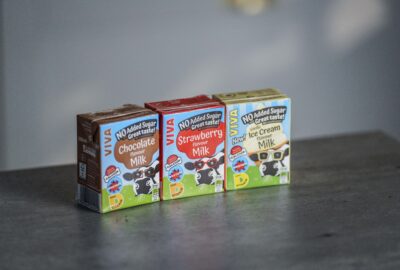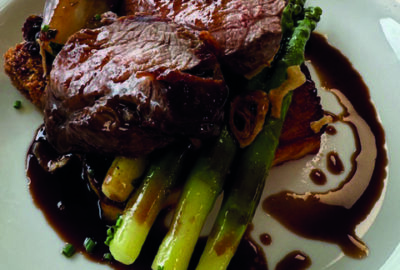Published in 2011, Niki Segnit’s first book – The Flavour Thesaurus – quickly became a global phenomenon and bestseller. Revered not just by home-cooks but by leading mixologists, baristas, and chefs including heavyweights such as Nigella Lawson, Nigel Slater, Yotam Ottolenghi and Heston Blumenthal, the book also famously featured in the Cameron’s “shelfie” image at Downing Street. We caught up with Niki to discuss her incredible food odyssey, Lateral Cooking, and the hugely-anticipated sequel – The Flavour Thesaurus: More Flavours.
What are your first memories of food? Was it something you were involved in or interested in growing up?
I come from a family that wasn’t exactly a bunch of gourmets, but we loved our food. My dad used to work late but my sister and I always sat down to eat together with my mum each evening. Mum would always cook from scratch so while it didn’t spark any major interest in cooking at that age, it definitely laid a foundation of understanding about what real food tastes like and can be.
How did you go from advertising to being a successful published food writer/author? Was it planned?
I do talks at Leith’s cooking school sometimes and I meet a lot of people who are mature students who have been working in some non-food industry but have been sitting at their desk dreaming of doing something culinary. I was one of those.
What planted the seed for The Flavour Thesaurus?
Because I cooked recipes from lots and lots of different countries and regions, I had a very good idea of flavour principles. I was always interested when I came across a pairing that seemed unlikely. For example strawberries
and balsamic vinegar and chocolate and chilli. What I wanted to know was ‘what is it that makes those two things special together?’. The actual trigger moment was when I was watching MasterChef and saw someone pair butternut squash with blueberries. The next day I went out to try and find a book that focused on pairing and why and how certain foods or drinks worked together. I went to a bookshop and then started searching on Amazon and around the internet and I just couldn’t find anything. My husband, who is a writer, said “maybe you should write it”. A week or so after that, the title ‘The Flavour Thesaurus’ just came into my head as I was sat at my desk. And that was it really.
How did you go about putting it together?
I love my Roget’s Thesaurus, which is where the book’s title came from, so I had a form for my book. The back is a sort of grab and go list of ingredients of what goes with what. Something to jolt the memory. The front section is an elaboration on each pairing. It draws on lots of opinions from chefs and food writers about what works and in what recipes but in the end I had to do a lot of research into the ‘why’. It’s not something that’s been written about for chefs or home cooks. I had to read up on flavour chemistry, teaching myself all I could from the books written for people who work in that industry.
Will we ever run out of flavour combinations or will this continue to evolve?
I think the maths is in the first chapter of the Flavour Thesaurus. If you take pairings of 99 ingredients, there are something like 4,500 possible combinations. If you look at trios of the 99 ingredients – it’s something like 156,849 possible combinations. There is a great episode of More or Less on Radio 4 about the chances of Ed Sheeran coming up with the same chords as the song in a copyright case. When you introduce lots of variables or ingredients, there’s a huge amount of scope for originality.
Do you have a favourite food pairing?
Personally, I get very excited about coffee combinations. One I love is coffee and blackcurrant. I had a dessert where both those flavours pushed really hard and worked so beautifully together. When I googled that combination, there were 1 or 2 ideas but now you will find so many more with the explosion of creativity and the recording of it online.
Any flavours you hate?
I don’t like mushrooms and most food dislikes are about the texture rather than the flavour. It’s why you find lots of people who don’t like okra, rhubarb and celery. I don’t like rhubarb and ginger. I think that’s a really harsh and unpleasant combination but it’s a classic and lots of people do like it. If you have something repeatedly – like if your grandma was always making her rhubarb crumble with ginger – then you tend to get used to it and like it. That primarily informs what each of us thinks works together – what we’re exposed to a lot.
Tell us about the new book – The Flavour Thesaurus: More Flavours
At first, I thought I would try and stick to vegan parameters but that didn’t work for me. It takes too long to explain recipes and methods which would be required by most of the people who read my book, who I think, like me, are interested in cooking as opposed to being actually vegan. Long explanations just don’t work with the form of this book. The entries need to be short and snappy. So, I added yoghurt, eggs, cheese and honey and it worked well. The book organically became plant-led as opposed to vegan. It’s not meat-free, but it is not meat-centric. The world does not always have to be meat first.
Who was the biggest impact on you?
MFK Fisher – an American writer who is sadly no longer with us. She wrote a short piece which was called – ‘I Was Really Very Hungry’ – about a meal she ate alone in France. That was my favourite piece of food writing that hooked me and made me want to do something similar.
What’s your favourite piece of kitchen equipment?
The radio. I can make something with a bowl and a wooden spoon. I don’t need fancy equipment but I do love music as I cook.
Which four people would you love to cook for?
MFK Fisher, Nigella Lawson, Elisabeth Luard and Yotam Ottolenghi. I would probably cook a really good chicken and coconut curry.
Would you be nervous cooking for these guests?
I cooked for six ordinary friends the other day and I was nervous. I was probably playing it safe for a few years but recently I read a book by Kate Young and it inspired me to take a few more risks and push myself. So, I did last week as I had 6 friends around and I was very nervous but it was fun. Cooking for people who cook for a living would be very difficult, but I think they’d all be very forgiving. And the conversation would be good.
Which ingredient can’t you live without?
Cauliflower. Pizza dough, rice, soup etc. I love it as an ingredient. Roasted cauliflower with cumin features at least once a week in my house.
Any new combinations that sounded strange to you but you’re now hooked on?
In the new book, I had to write about coffee and yoghurt. I kept putting it off as it sounded horrible to me but I know in the US and in some European countries it’s quite a big flavour. People have tried to launch it here under all kinds of guises. For example, we’ve seen latte yoghurts, cappuccino yoghurts, expresso martini yoghurts and they always failed. I was reading an ice cream book from a woman who runs an artisan ice cream gelateria. She said she would never do coffee and yoghurt because the flavours didn’t work together. I completely agreed at the time and then I made some coffee yoghurt and it was fantastic – a really exciting flavour. I tried it on an audience the other night. One wrote to me the next day and said she’d just had it for pudding and it’s her new favourite thing. Another wrote and said he thought it was ‘rancid’!
Your guilty food pleasure?
I’m not a big fast-food fan but fish and chips would be my pick. With a mushy pea fritter on the side.
What’s next?
I’m having a bit of a break this time. I went straight from the other two books into the next so I’m going to see this one out properly. I’m going up to Glasgow to do a festival and I will be at Abergavenny, Latitude and some London events this summer so hopefully some chefs will come out and see me.
What’s your Signature Dish?
I’m going for my Maple Syrup & Fennel Tart. It’s not based on a Canadian or American maple tart but more on a UK treacle tart but instead of lemon, I used fennel to pick out the subtle flavours in the maple syrup. It’s really nice!


